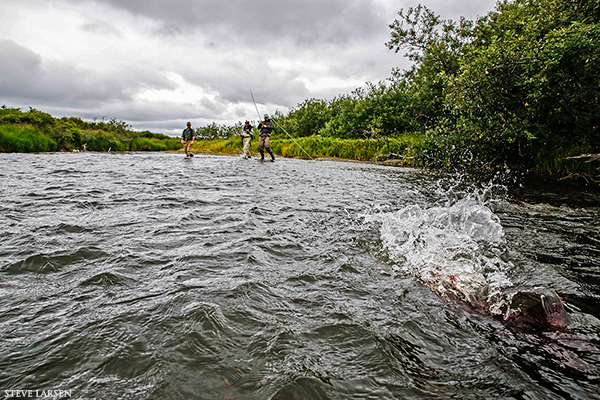
Many anglers come to Alaska to experience the thrill of hooking the largest of the Pacific Salmon species – the renowned King Salmon (Chinook Salmon). These beastly salmonids can get up to 70lbs+ in our local waters. But hooking a fish like this is only the beginning. Successfully fighting and landing a 45 lb freight train bound for the salt is no easy task. Here are 3 helpful tips for fighting a big King:
-
Set the hook, and then set it again!
When a big King Salmon eats your fly/lure/plug or whatever, you know that’s only the beginning of a long battle. Sometimes our initial hook sets are weak because of our unassuming position during the retrieve. Or maybe, you just weren’t ready for the strike. If you don’t get a solid hook set the first time when you initially feel the tug, don’t be afraid to raise the rod hard again, giving the fish a 2nd or 3rd hook set. Trust me, you want to make sure you’ve sunk the hook because these fish are ferocious, and you need every advantage you can get to keep them on.
-
Chase the fish!
If you have a King Salmon on, and he’s acting like an upset sea monster headed back to Bristol Bay from which he came, he’s going to take some line. This is part of the fun in catching large feisty fish. But having your backing slowly disappearing off your real is not a promising sign of landing your salmon. The more line you have out there, the better chance that King Salmon has at rubbing your hook off or breaking your line. Take control. Tighten your drag a few clicks and see if you can make up ground on the fish, by walking/drifting/motoring toward the runaway freight train. Your guide will assist in this effort. Reel in as you get closer and closer to the fish, making sure to keep a steady bend in the rod without too much bouncing or irregular motion. Once you have that dog on a short leash, your chance to land the fish has improved drastically.
-
Make the fish work!
King Salmon are heavy – often really heavy. At times (especially with fly rods) Kings can simply use the current and their weight to rest lazily behind a rock mid-river. In this instance, the fish is playing the long game – hoping that time and impatience will set them free. Depending on circumstances, letting a fish hunker down like this doesn’t help your chances. But, you can’t just winch the fish out without the proper technique. The real key to making a fish work is to apply side pressure. Side pressure is when you direct your force 90 degrees from where the fish is facing. Most anglers do this by lowing their rod tip to waist height or lower. The result is the best mechanical and physical angle for moving that fish. Some people call this technique,“walking the dog.“ When applying the side pressure, slowly move your rod upstream. As you do this, the fish obviously is heading upstream as well. Sort of like, well, walking your dog. You are leading the fish where you want him to go.
